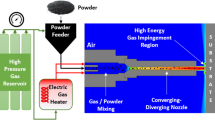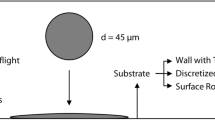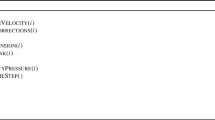Abstract
Thermal barrier coatings produced by plasma spraying have a characteristic microstructure of lamellae, pores, and cracks. The lamellae form when particles splash onto the substrate. As the coating grows, the lamellae pile on top of one another, producing an interlocking structure. In most cases the growth is rapid and chaotic, resulting in a microstructure characterized by pores and cracks. This paper presents an improved model for the deposition process of thermal barrier coatings. The task of modeling the coating growth is divided into two parts. First, a description of the particle on arrival at the film is given based on the available theoretical, numerical, and experimental findings. Second, a set of physically based rules for combining these events to obtain the film is defined and discussed. The splats run along the surface and are permitted to curl up (producing pores) or to interlock. The computer model uses a mesh to combine these processes and build the coating. The proposed model can be used to predict microstructures and hence to correlate the properties of these coatings with the parameters of the process used to make them.
Similar content being viewed by others
References
P. Fauchais, A. Grimaud, A. Vardelle, and M. Vardelle, La Projection par Plasma: Une Revue,Ann. Phys., Vol 14, 1989, p 261–310 (in French)
G. Trapaga and J. Szekely, Mathematical Modeling of the Isothermal Impingement of Liquid in Spraying Processes,Metall. Trans. B, Vol 22B, 1991, p 901–914
M. Bertagnolli, M. Marchese, and G. Jacucci, Modeling of Particles Impacting on a Rigid Substrate for Plasma-Sprayed Coatings,J. Therm. Spray Technol., in press
A. Vardelle, M. Vardelle, and P. Fauchais, Les Transferts de Quantité de Mouvement et de Chaleur Plasma Particules Solides dans un Plasma d’Arc in Extinction,Rev. Int. Hautes Temp. Refract., Vol 23,1986, p 69–85 (in French)
R. Westhoff, G. Trapaga, and J. Szekely, Plasma-Particle Interactions in Plasma Spraying Systems,Metall. Trans. B, Vol 23B, 1992, p 683–693
O. Knotek and R. Elsing, Monte Carlo Simulation of the Lamellar Structure ofThermally Sprayed Coatings,Surf. Coat. Technol.,Vol32, 1987, p 261–271
H. Fukanuma, An Analysis of the Porosity Producing Mechanism,Thermal Spray: International Advances in Coatings Technology, C.C. Berndt, Ed., ASM International, 1992, p 767-772
J. Madejski, Solidification of Droplets on a Cold Surface,J. Heat Mass Transfer, Vol 19,1976, p 1009–1013
P.Yu. Pekshev and I.G. Murzin, Modelling of Porosity of Plasma Sprayed Materials,Surf. Coat. Technol., Vol 56,1993,p 199–208
P.H. Harmsworth and R. Stevens, Microstructure of Zirconia-Yttria Plasma-Sprayed Thermal Barrier Coatings,J. Mater. Sci., Vol 27, 1992, p 616–624
R. McPherson, A Review of Microstructure and Properties of Plasma Sprayed Ceramic Coatings,Surf. Coat. Technol., Vol 39/40, 1989, p 173–181
S. Safai and H. Herman, Microstructural Investigation of Plasma- Sprayed Aluminum Coatings,Thin Solid Films, Vol 45, 1977, p 295- 307
S. Kuroda, T. Fukushima, and S. Kitahara, Simultaneous Measurement of Coating Thickness and Deposition Stress during Thermal Spraying,Thin Solid Films, Vol 164,1988, p 157–163
S. Cirolini, J.H. Harding, and G. Jacucci, Computer Simulation of Plasma-Sprayed Coatings. I. Coating Deposition Model,Surf. Coat. Technol., Vol 48, 1991, p 137–145
S. Fantassi, M. Vardelle, P. Fauchais, and C. Moreau, Investigation of the Splat Formation Versus Different Particulate Temperatures and Velocities prior to Impact,Thermal Spray: International Advances in Coatings Technology, C.C. Berndt, Ed., ASM International, 1992, p 755-760
G. Trapaga, E.F. Matthys, J.J. Valencia, and J. Szekely, Fluid Flow, Heat Transfer, and Solidification of Molten Metal Droplets Impinging on Substrates: Comparison of Numerical and Experimental Results,Metall. Trans. B, Vol 23B, 1992, p 701–718
J.M. Houben, “Relation of the Adhesion of Plasma Sprayed Coatings to the Process Parameters Size, Velocity and Heat Content of the Spray Particles,” Ph.D. thesis, Technische Universiteit, Eindhoven, The Netherlands, 1988
R. McPherson and V. Shafer, Interlamellar Contact within Plasma- Sprayed Coatings,Thin Solid Films, Vol 97,1982, p 201–204
L. Pawlowski, M. Vardelle, and P. Fauchais, A Model for the Temperature Distribution in an Alumina Coating during Plasma Spraying,Thin Solid Films, Vol 94,1982, p 307–319
L. Bertamini, S. Sturlese, and P. Beber, Atmosphere and Temperature Controlled Spraying (ATCS) of Thermal Barrier Coating on Aluminum Alloys,Proc. Int. Symp. Automotive Technology and Automization, Aachen, 1993
Author information
Authors and Affiliations
Rights and permissions
About this article
Cite this article
Harding, J.H., Mulheran, P.A., Cirolini, S. et al. Modeling the deposition process of thermal barrier coatings. JTST 4, 34–40 (1995). https://doi.org/10.1007/BF02648526
Issue Date:
DOI: https://doi.org/10.1007/BF02648526




